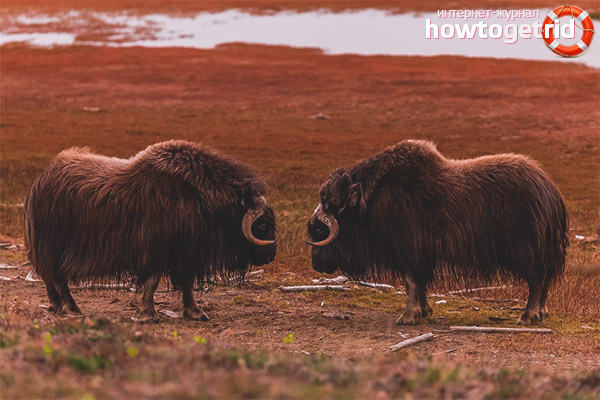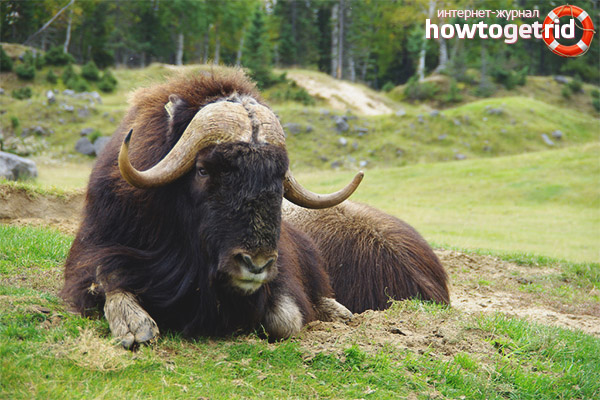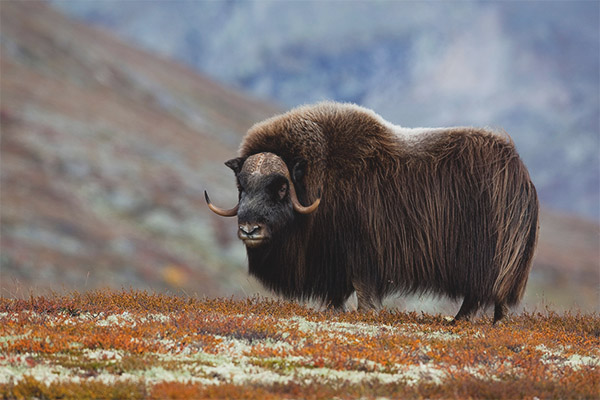The content of the article
Musk ox, or as it is also called musk ox, was singled out by specialists in a separate unit because of its unique qualities. They have long hair and gentle tail of a sheep and horns of a bull. They belong to the family of bovids, in which they form 2 subspecies: the first has chosen the north of Canada, and the second has chosen Greenland and the Canadian islands as its main habitat. Representatives of both subspecies, in addition to these, the main regions, also live in a small number in Sweden, Norway and Siberia. Moreover, his neighbor, the reindeer, lives in almost the same latitudes as the musk ox.
In scientific circles there are still disputes related to the systematization of the position of these animals, but in the opinion of most scientists they should be attributed to the subfamily goat, whereas prior to the beginning of the XIX century they were attributed to another subfamily - bovine.This confusion is most likely due to the fact that the young oxen calves are called calves rather than lambs, and the females of the females, respectively, are also called calving, and not lambing.
Habitat and specific features
Modern scientists believe that the musk oxen are the only representatives of this genus. Also, scientists assume that their ancestors living in the Miocene inhabited the central part of the Asian continent, in particular, the Himalayan mountains. Approximately 3.5 million years ago, their ancestors migrated to the north of Asia. In the Illinois, as a result of glaciation, they were able to spread to the north of the American continent and to present-day Greenland. The livestock of animals greatly decreased 130 thousand years ago - as a result of a sharp warming. This period was successfully transferred to the oxen and reindeer.
Musk oxen, recently living in the Arctic, almost completely disappeared from the territory of Eurasia. From the territory of Alaska, this species disappeared in the nineteenth century, but was again introduced in the first half of the twentieth. Today, about 800 animals of this species live in Alaska,and their population continues to grow. In the Russian Federation, this species settled on the territory of Wrangel Island and the Taimyr Peninsula. The territories where these animals live in our country are protected and protected by relevant legislation. Today the general population totals up to 25 thousand heads.
The appearance of animals was shaped by the nature of life and their environment. So, to reduce the heat loss of the body and prevent frostbite, there are no protruding parts of the carcass. In addition, their bodies are covered with long and thick brown or black wool. By the way, color is important in order to catch crumbs of solar heat (but there are also white animals, very rarely). From the wool of the musk oxen, only the hooves, lips, nose and horns protrude. Before the summer period, animals shed, and their hair becomes shorter, but by winter it grows back and a soft undercoat appears. The wool of musk oxen is highly valued, and the wool of white musk ox is especially appreciated.
The head of the animal is powerful and slightly elongated compared to the rest of the carcass. In addition to the horns, there are eyes (dark brown) and small (about six centimeters) ears on it. The tail is small (about 15 centimeters). Smell and sight - excellent, able to see in the dark. And enemies and friends, in addition to sight, are distinguished by smell.
The largest specimens are found in the West of Greenland, and the smallest in the North. The musk ox does not look like a yak or a bison, for example, not only externally, their diploid set of chromosomes also differs: the musk ox has 48 pairs of chromosomes, and the bison and yak have 60 pairs each.
The name is musky, musk ox acquired due to the fact that its glands produce a special secret that has a pronounced smell.
Musk ox lifestyle and his character

Musk oxen live in groups whose numbers vary in winter and summer: respectively, up to 20 in winter and up to 20 in summer. At the same time, each group of animals does not secure the territory of habitat, but when moving it uses the same routes that are marked. In groups of animals, the dominance of more adult animals over young ones is observed, while in winter this may be expressed in the fact that adult animals can force the young from places of richer food. As already mentioned, the groups of musk oxen move by certain routes, while in winter and summer the directions of these routes are different. So, in the winter, they prefer to move in the direction of the south, and in the summer - they seek food, moving along the banks of the rivers. These are very hardy animals that are able to keep running at speeds up to 40 km / h for quite a long time if they are in danger. However, due to their size, they are slow and unhurried.And if there is no need, they do not make long transitions.
Frosts in their habitats sometimes fall below 60 degrees Celsius below zero. Such a cold is easier to carry, having a long, thick coat and thick undercoat, as well as subcutaneous fat.
The enemies
Natural enemies in the habitats of musk oxen are bears (grizzly and polar) and polar wolves, however, musk oxen are not a timid animal and when attacked, for example, by a single wolf, musk oxen are inside the ring, inside which are calves and females. When attacking, the musk oxen allow everything that nature has given them for defense and defense (hooves and horns). This method of defense does not work when the attacker is a man with a gun, then a person using this method of protecting animals can exterminate all the animals in the herd.
When danger arises, the musk oxen wheeze, snort and roar, and the calves bleat.
Over the previous century, the livestock of animals has decreased significantly, however, due to the observance of rules by hunters and the fight against poaching, the livestock is gradually increasing.
Nutrition

In addition to the protection functions, the task of the leader also includes the search for pasture.In winter, animals move less, which, firstly, helps to reduce calorie intake, and secondly, contributes to the digestion of food. In the habitats of musk oxen there is no large variety of plant foods, so their diet is quite poor. Due to the fact that the Arctic summer is short, musk oxen do not have time to accumulate enough fat, they have to be content with dry plants, which they extract from under the snow. However, in this they really succeeded: the musk ox can sense and get food from a depth of half a meter. For the winter period, mosses and lichens are added to their diet, and if they are lucky, dwarf tundra plants are added. And in winter, the animals try to stay on the slopes of the mountains, where the wind blows snow, providing free access to food.
In summer, the diet is enriched by sedge and foliage. In addition, in the summer, musk oxen are looking for salt licks in order to replenish the diet with the necessary macro and microelements.
Reproduction and longevity
The mating season of these animals begins with the end of the summer and lasts a couple of months. Females and juveniles form groups for which males begin to fight in duels.The winners of such fights form their harem, to which the aggressive owner does not let anyone even close.
Economic value
In addition to the brown and white wool of the musk oxen, which has already been mentioned, their undercoat, called the giviot, is also valuable. During the molt from one animal, you can get up to 2 kilograms of undercoat.From animals living in captivity, giviot get combed, and wild giviot collected from vegetation in habitats. Animal meat is like beef, and fat resembles mutton. However, meat and fat have a rather pronounced musky smell.
Video: musk ox (Ovibos moschatus)











To send